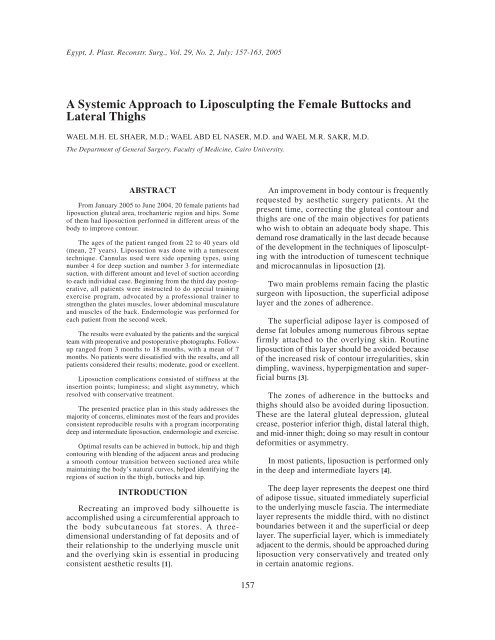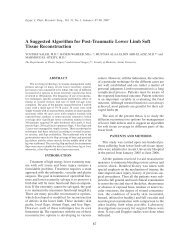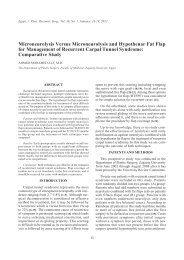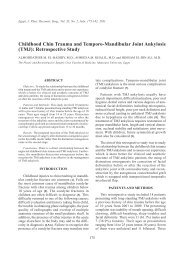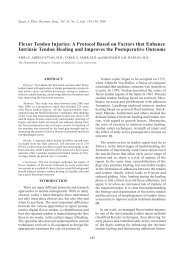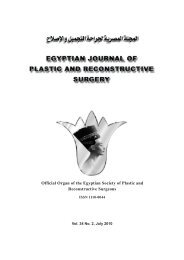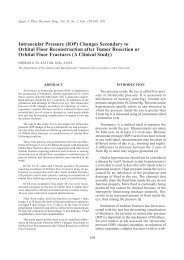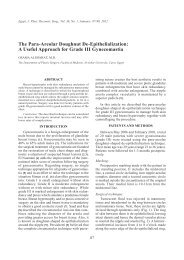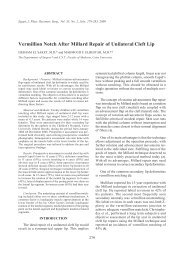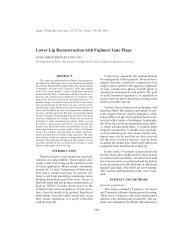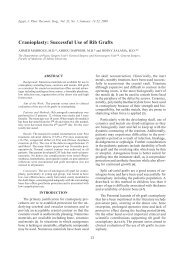A Systemic Approach to Liposculpting the Female Buttocks ... - ESPRS
A Systemic Approach to Liposculpting the Female Buttocks ... - ESPRS
A Systemic Approach to Liposculpting the Female Buttocks ... - ESPRS
Create successful ePaper yourself
Turn your PDF publications into a flip-book with our unique Google optimized e-Paper software.
Egypt, J. Plast. Reconstr. Surg., Vol. 29, No. 2, July: 157-163, 2005<br />
A <strong>Systemic</strong> <strong>Approach</strong> <strong>to</strong> <strong>Liposculpting</strong> <strong>the</strong> <strong>Female</strong> But<strong>to</strong>cks and<br />
Lateral Thighs<br />
WAEL M.H. EL SHAER, M.D.; WAEL ABD EL NASER, M.D. and WAEL M.R. SAKR, M.D.<br />
The Department of General Surgery, Faculty of Medicine, Cairo University.<br />
ABSTRACT<br />
From January 2005 <strong>to</strong> June 2004, 20 female patients had<br />
liposuction gluteal area, trochanteric region and hips. Some<br />
of <strong>the</strong>m had liposuction performed in different areas of <strong>the</strong><br />
body <strong>to</strong> improve con<strong>to</strong>ur.<br />
The ages of <strong>the</strong> patient ranged from 22 <strong>to</strong> 40 years old<br />
(mean, 27 years). Liposuction was done with a tumescent<br />
technique. Cannulas used were side opening types, using<br />
number 4 for deep suction and number 3 for intermediate<br />
suction, with different amount and level of suction according<br />
<strong>to</strong> each individual case. Beginning from <strong>the</strong> third day pos<strong>to</strong>perative,<br />
all patients were instructed <strong>to</strong> do special training<br />
exercise program, advocated by a professional trainer <strong>to</strong><br />
streng<strong>the</strong>n <strong>the</strong> glutei muscles, lower abdominal musculature<br />
and muscles of <strong>the</strong> back. Endermologie was performed for<br />
each patient from <strong>the</strong> second week.<br />
The results were evaluated by <strong>the</strong> patients and <strong>the</strong> surgical<br />
team with preoperative and pos<strong>to</strong>perative pho<strong>to</strong>graphs. Followup<br />
ranged from 3 months <strong>to</strong> 18 months, with a mean of 7<br />
months. No patients were dissatisfied with <strong>the</strong> results, and all<br />
patients considered <strong>the</strong>ir results; moderate, good or excellent.<br />
Liposuction complications consisted of stiffness at <strong>the</strong><br />
insertion points; lumpiness; and slight asymmetry, which<br />
resolved with conservative treatment.<br />
The presented practice plan in this study addresses <strong>the</strong><br />
majority of concerns, eliminates most of <strong>the</strong> fears and provides<br />
consistent reproducible results with a program incorporating<br />
deep and intermediate liposuction, endermologie and exercise.<br />
Optimal results can be achieved in but<strong>to</strong>ck, hip and thigh<br />
con<strong>to</strong>uring with blending of <strong>the</strong> adjacent areas and producing<br />
a smooth con<strong>to</strong>ur transition between suctioned area while<br />
maintaining <strong>the</strong> body’s natural curves, helped identifying <strong>the</strong><br />
regions of suction in <strong>the</strong> thigh, but<strong>to</strong>cks and hip.<br />
INTRODUCTION<br />
Recreating an improved body silhouette is<br />
accomplished using a circumferential approach <strong>to</strong><br />
<strong>the</strong> body subcutaneous fat s<strong>to</strong>res. A threedimensional<br />
understanding of fat deposits and of<br />
<strong>the</strong>ir relationship <strong>to</strong> <strong>the</strong> underlying muscle unit<br />
and <strong>the</strong> overlying skin is essential in producing<br />
consistent aes<strong>the</strong>tic results [1].<br />
157<br />
An improvement in body con<strong>to</strong>ur is frequently<br />
requested by aes<strong>the</strong>tic surgery patients. At <strong>the</strong><br />
present time, correcting <strong>the</strong> gluteal con<strong>to</strong>ur and<br />
thighs are one of <strong>the</strong> main objectives for patients<br />
who wish <strong>to</strong> obtain an adequate body shape. This<br />
demand rose dramatically in <strong>the</strong> last decade because<br />
of <strong>the</strong> development in <strong>the</strong> techniques of liposculpting<br />
with <strong>the</strong> introduction of tumescent technique<br />
and microcannulas in liposuction [2].<br />
Two main problems remain facing <strong>the</strong> plastic<br />
surgeon with liposuction, <strong>the</strong> superficial adipose<br />
layer and <strong>the</strong> zones of adherence.<br />
The superficial adipose layer is composed of<br />
dense fat lobules among numerous fibrous septae<br />
firmly attached <strong>to</strong> <strong>the</strong> overlying skin. Routine<br />
liposuction of this layer should be avoided because<br />
of <strong>the</strong> increased risk of con<strong>to</strong>ur irregularities, skin<br />
dimpling, waviness, hyperpigmentation and superficial<br />
burns [3].<br />
The zones of adherence in <strong>the</strong> but<strong>to</strong>cks and<br />
thighs should also be avoided during liposuction.<br />
These are <strong>the</strong> lateral gluteal depression, gluteal<br />
crease, posterior inferior thigh, distal lateral thigh,<br />
and mid-inner thigh; doing so may result in con<strong>to</strong>ur<br />
deformities or asymmetry.<br />
In most patients, liposuction is performed only<br />
in <strong>the</strong> deep and intermediate layers [4].<br />
The deep layer represents <strong>the</strong> deepest one third<br />
of adipose tissue, situated immediately superficial<br />
<strong>to</strong> <strong>the</strong> underlying muscle fascia. The intermediate<br />
layer represents <strong>the</strong> middle third, with no distinct<br />
boundaries between it and <strong>the</strong> superficial or deep<br />
layer. The superficial layer, which is immediately<br />
adjacent <strong>to</strong> <strong>the</strong> dermis, should be approached during<br />
liposuction very conservatively and treated only<br />
in certain ana<strong>to</strong>mic regions.
158 Vol. 29, No. 2 / A <strong>Systemic</strong> <strong>Approach</strong> <strong>to</strong> <strong>Liposculpting</strong> <strong>the</strong> <strong>Female</strong> But<strong>to</strong>cks<br />
These fac<strong>to</strong>rs limit <strong>the</strong> degree of improvement<br />
that can be obtained by liposuction surgery alone<br />
[3].<br />
At <strong>the</strong> present time, patients have various,<br />
different alternatives because of <strong>the</strong> arrival of new<br />
techniques. Undoubtedly, one advance is <strong>the</strong> endermologie,<br />
which is a non-invasive mechanical<br />
method of “aspirated hypodermal mobilization”<br />
that mobilizes superficial adipose layer through a<br />
mo<strong>to</strong>rized rhythmic folding-unfolding and suctionassisted<br />
massage technique that has been advocated<br />
for body con<strong>to</strong>uring and cellulite treatment [4].<br />
Understanding of <strong>the</strong> aes<strong>the</strong>tically pleasing<br />
human form is fundamental. Many authors have<br />
described <strong>the</strong> aes<strong>the</strong>tically pleasing female silhouette.<br />
Viewed from behind, <strong>the</strong> lower <strong>to</strong>rso-upper<br />
thigh area in women is characterized by a gently<br />
undulating double curve with a diminutive fullness<br />
at about <strong>the</strong> level of <strong>the</strong> iliac crest and a larger<br />
swelling at <strong>the</strong> trochanteric area. The hip and thigh<br />
protuberances are separated by <strong>the</strong> gluteal recess.<br />
This normal double curve, glorified by classical<br />
figurative painters, is ana<strong>the</strong>ma <strong>to</strong> women of <strong>the</strong><br />
late Twentieth Century, who seek a slimmer, more<br />
boyish look. These women want ablation of <strong>the</strong><br />
double curve and its replacement by a single smooth<br />
curve with slight convexity when viewed from<br />
behind [1].<br />
The gluteal crease separates <strong>the</strong> posterior upper<br />
thigh from <strong>the</strong> but<strong>to</strong>ck and extends laterally a<br />
variable distance from <strong>the</strong> medial thigh, typically<br />
ending about two-thirds of <strong>the</strong> way <strong>to</strong> <strong>the</strong> lateral<br />
most portion of <strong>the</strong> thigh. Viewed from <strong>the</strong> side,<br />
<strong>the</strong> youthful gluteal mass meets <strong>the</strong> upper thigh at<br />
an obtuse angle and <strong>the</strong> upper but<strong>to</strong>ck projects as<br />
a rounded, subtle fullness slightly more than balance<br />
<strong>the</strong> anterior projection of <strong>the</strong> breasts [5].<br />
Most reports have documented <strong>the</strong> need <strong>to</strong><br />
address <strong>the</strong> hips and trochanteric regions as well<br />
as <strong>the</strong> bulk of <strong>the</strong> but<strong>to</strong>ck. The frame of <strong>the</strong> but<strong>to</strong>ck<br />
consists of <strong>the</strong> hip fat pad, which may merge with<br />
<strong>the</strong> upper outer quadrant of <strong>the</strong> but<strong>to</strong>cks producing<br />
an exaggerated appearance of width and height of<br />
origination; and <strong>the</strong> trochanteric fat pad, which<br />
may merge with <strong>the</strong> inferior outer quadrant of <strong>the</strong><br />
but<strong>to</strong>cks producing an exaggerated appearance of<br />
width in <strong>the</strong> lower but<strong>to</strong>cks [6].<br />
Actually <strong>the</strong>re is a wide range of deformities<br />
affecting <strong>the</strong> hip region in females, and it has been<br />
classified by many authors as Pitman, who described<br />
three general types according <strong>to</strong> <strong>the</strong> amount of fat<br />
and <strong>to</strong>ne of skin [7]. Gasparotti, et al., described<br />
four variations of saddlebag deformities [8].<br />
Grazer and Klingbeil developed an ana<strong>to</strong>mic<br />
classification of female hip and thigh deformities<br />
based on <strong>the</strong> deviation from normal.<br />
Their classification was revised in 1984 <strong>to</strong><br />
conform <strong>to</strong> <strong>the</strong> requirements of liposuction <strong>to</strong> treat<br />
type I through type VII deformities:<br />
Type I : Has excess subcutaneous fat in <strong>the</strong> medial<br />
thighs, often in combination with o<strong>the</strong>r<br />
body deformities.<br />
Type II : Typified by <strong>the</strong> saddle bag trochanteric<br />
bulge, is often seen in ec<strong>to</strong>morphs and<br />
mesomorphs.<br />
Type III: Combine a trochanteric deformity and<br />
an additional bulging of <strong>the</strong> upper hip<br />
or flanks.<br />
Type IV: Is a composite of type II and III, with a<br />
deepened midgluteal depression.<br />
Type V : Is typical endomorphic obesity.<br />
Type VI : Traumatic or congenital deformities.<br />
Type VII: Deformities typify <strong>the</strong> sagging and wrinkling<br />
but<strong>to</strong>cks caused by aging [5].<br />
Although classification is extremely helpful,<br />
<strong>the</strong> surgeon must individualize <strong>the</strong> procedure for<br />
each patient. Numerous techniques have been<br />
described for <strong>the</strong> con<strong>to</strong>uring of but<strong>to</strong>ck, hip and<br />
thigh regions. Especially young plastic surgeons<br />
will be faced with a wide range of liposuction<br />
procedures with a wide range of possible complications.<br />
Also <strong>the</strong>re is a paucity of literature describing<br />
an integrated approach <strong>to</strong> <strong>the</strong> management of<br />
this condition.<br />
On this basis, a practice plan is presented in<br />
this study that addresses <strong>the</strong> majority of concerns,<br />
and eliminates most of <strong>the</strong> fears and provides<br />
consistent reproducible results with a program<br />
incorporating deep and intermediate liposuction,<br />
endermologie and exercise. The aim is <strong>to</strong> optimize<br />
<strong>the</strong> results of but<strong>to</strong>ck, hip and thigh con<strong>to</strong>uring<br />
with blending of <strong>the</strong> adjacent areas and producing<br />
a smooth con<strong>to</strong>ur transition between suctioned<br />
areas while maintaining <strong>the</strong> body’s natural curves,<br />
helped by identifying <strong>the</strong> regions of suction in <strong>the</strong><br />
thigh, but<strong>to</strong>cks and flanks.<br />
PATIENTS AND METHODS<br />
During eighteen months period, from January<br />
2003 <strong>to</strong> June 2004, 20 female patients were operated<br />
on. They ranged in age from 22 <strong>to</strong> 40 years<br />
old (mean, 27 years). All had liposuction performed<br />
in <strong>the</strong> gluteal areas and <strong>the</strong> trochanteric region and<br />
hips, some of <strong>the</strong>m had liposuction performed in<br />
different areas of <strong>the</strong> body <strong>to</strong> improve con<strong>to</strong>ur.
Egypt, J. Plast. Reconstr. Surg., July 2005 159<br />
The types of deformities were different and not<br />
uniform, but all were within types II, III and IV<br />
of Grazer and Klingbeil ana<strong>to</strong>mic classification.<br />
Preoperative analysis were performed in all<br />
patients, <strong>the</strong>se included <strong>the</strong> determination of hemoglobin<br />
and hema<strong>to</strong>crite levels; prothrombin<br />
time, and partial thromboplastin time; serum glucose,<br />
creatinine and urea level and liver enzymes.<br />
All patients were medically fit for operation. All<br />
patients were managed under anes<strong>the</strong>siologistmoni<strong>to</strong>red<br />
intravenous sedation or under general<br />
inhalational anes<strong>the</strong>sia. Antibiotic prophylaxis with<br />
1gm. Of cephalexin, given two hours before surgery<br />
and continued once every 8 hours for 24 hours<br />
after surgery. In <strong>the</strong> immediate preoperative period<br />
a single hydrocortisone dose was given.<br />
Intraoperative marking is performed with <strong>the</strong><br />
patient nude and erect. Because gravity is important,<br />
<strong>the</strong> most prominent areas are marked with <strong>the</strong><br />
patient erect. Left/right asymmetry and volumetric<br />
inequalities are noted for correction.<br />
As all ana<strong>to</strong>mic areas in <strong>the</strong> region of <strong>the</strong> hip,<br />
thigh and but<strong>to</strong>cks merge <strong>to</strong>ge<strong>the</strong>r with special<br />
curves, no single area can be approached alone.<br />
Each aes<strong>the</strong>tic unit should be framed during liposuction.<br />
We classified <strong>the</strong>se regions in<strong>to</strong> 9 specific<br />
areas as shown in <strong>the</strong> diagram and <strong>the</strong> areas approached<br />
are individualized <strong>to</strong> <strong>the</strong> patient’s deformity<br />
and expectations. In <strong>the</strong> classification proposed<br />
all <strong>the</strong> regions were classified according <strong>to</strong> ana<strong>to</strong>mic<br />
areas and merged intentionally in<strong>to</strong> adjacent areas,<br />
<strong>the</strong>se include:<br />
Table (1): Amount infilterated, suctioned areas suctioned and complication.<br />
Patient<br />
number<br />
1<br />
2<br />
3<br />
4<br />
5<br />
6<br />
7<br />
8<br />
9<br />
10<br />
11<br />
12<br />
13<br />
14<br />
15<br />
16<br />
17<br />
18<br />
19<br />
20<br />
Amount<br />
infiltrated<br />
2000<br />
2500<br />
1000<br />
2700<br />
3000<br />
2000<br />
2000<br />
3000<br />
1500<br />
1500<br />
2000<br />
2500<br />
2500<br />
1000<br />
2500<br />
2000<br />
3000<br />
1500<br />
1500<br />
2000<br />
Amount<br />
aspirated<br />
2650<br />
3100<br />
1000<br />
3300<br />
5600<br />
3590<br />
2600<br />
3400<br />
2200<br />
2150<br />
2500<br />
3000<br />
3200<br />
1700<br />
2900<br />
2600<br />
3500<br />
2000<br />
2100<br />
2800<br />
Aeas<br />
suctioned<br />
I,II,III,V,VI<br />
I,III,IV,V<br />
I,III,V<br />
I,III,V,VI<br />
I,II,III,IV,V,VII,IX<br />
I,II,III,V<br />
I,II,III,V<br />
I,II,III,V,IX<br />
I,II,III,V<br />
I,II,III,V<br />
I,III,V<br />
I,III,V,VI<br />
I,III,V,IX<br />
I,III,V,VI<br />
I,III,IV,V<br />
I,III,V,VI<br />
I,III,V,VI<br />
I,III,V<br />
I,III,V,VI<br />
I,III,V,VI<br />
Area I : Includes <strong>the</strong> trochanteric region with<br />
<strong>the</strong> upper hip.<br />
Area II : The upper two thirds of <strong>the</strong> anterior<br />
thigh.<br />
Area III : The lower third of <strong>the</strong> but<strong>to</strong>ck and <strong>the</strong><br />
upper third of <strong>the</strong> posterior thigh.<br />
Area IV : The lower two thirds of <strong>the</strong> posterior<br />
thigh.<br />
Area V : The lower part of <strong>the</strong> flank, <strong>the</strong> upper<br />
third of <strong>the</strong> but<strong>to</strong>ck and <strong>the</strong> lumbosacral<br />
region.<br />
Area VI : The middle third of <strong>the</strong> but<strong>to</strong>ck.<br />
Area VII : The lower third of <strong>the</strong> anterior thigh<br />
and suprapatellar region.<br />
Area VIII: Medial aspect of <strong>the</strong> knee and lower<br />
third of <strong>the</strong> medial thigh.<br />
Area IX : The upper two thirds of medial thigh.<br />
Liposuction was performed using <strong>the</strong> tumescent<br />
technique in all patients. A solution containing<br />
25ml. 2% lidocaine, 1ml of 1 : 1000 epinephrine<br />
and 1000 ml of lactated Ringer’s solution is injected<br />
in <strong>the</strong> deep and intermediate layers until <strong>the</strong> target<br />
tissues are turgid. Cannulas used were side opening<br />
types, using number 4 for deep suction and number<br />
3 for intermediate suction, with different amount<br />
and level of suction according <strong>to</strong> each individual<br />
case. Amounts injected and aspirated are shown<br />
in table (1).<br />
O<strong>the</strong>r areas<br />
(amount suctioned<br />
not included)<br />
Liposuction of <strong>the</strong> abdomen<br />
Liposuction of <strong>the</strong> abdomen<br />
Liposuction of <strong>the</strong> abdomen<br />
Liposuction of <strong>the</strong> abdomen<br />
Complications<br />
Stiffness at <strong>the</strong> insertion points<br />
—<br />
—<br />
—<br />
—<br />
—<br />
—<br />
Lumpiness<br />
—<br />
—<br />
—<br />
—<br />
—<br />
—<br />
—<br />
—<br />
—<br />
—<br />
Slight asymmetry<br />
—
160 Vol. 29, No. 2 / A <strong>Systemic</strong> <strong>Approach</strong> <strong>to</strong> <strong>Liposculpting</strong> <strong>the</strong> <strong>Female</strong> But<strong>to</strong>cks<br />
Pos<strong>to</strong>peratively all patients wore an elastic<br />
garment for six weeks, changing <strong>the</strong> size whenever<br />
it becomes loose. Beginning from <strong>the</strong> third day<br />
pos<strong>to</strong>perative, all patients were instructed <strong>to</strong> do<br />
special training exercise program, advocated by a<br />
professional trainee <strong>to</strong> streng<strong>the</strong>n <strong>the</strong> glutei muscles,<br />
lower abdominal musculature and muscles of <strong>the</strong><br />
back. These training courses continued for at least<br />
six weeks. Twelve sessions endermologie were<br />
performed for each patient from <strong>the</strong> 14 th day pos<strong>to</strong>perative,<br />
three times weekly, each session lasts<br />
for 40 minutes [9].<br />
In all patients, <strong>the</strong> results were evaluated with<br />
preoperative and pos<strong>to</strong>perative pho<strong>to</strong>graphs (Figs.<br />
1,2). Evaluations considered <strong>the</strong> patient satisfaction<br />
and <strong>the</strong> assessment of <strong>the</strong> surgical team; a scale of<br />
1 <strong>to</strong> 4 was used <strong>to</strong> rate <strong>the</strong> degree of patient and<br />
surgical team satisfaction (1, a bad result; 4, excellent<br />
improvement) [2].<br />
RESULTS<br />
The follow-up period ranged from 3 months <strong>to</strong><br />
18 months, with a mean of 7 months. In 4 patients<br />
liposuction was also done in areas o<strong>the</strong>r than those<br />
treated for gluteal and thigh improvement, three<br />
of <strong>the</strong>m did liposuction of <strong>the</strong> abdomen, and one<br />
case did liposuction for both arms. No additional<br />
aes<strong>the</strong>tic procedures were performed in any patient.<br />
In all 20 cases <strong>the</strong> frame of <strong>the</strong> but<strong>to</strong>cks has been<br />
addressed, by sculpting <strong>the</strong> hip and <strong>the</strong> trochanteric<br />
region of <strong>the</strong> thigh (areas I, III, V). Debulking of<br />
<strong>the</strong> gluteal region, by suctioning area VI, was done<br />
in 8 cases only in order <strong>to</strong> achieve projection<br />
balanced with <strong>the</strong> anterior projection of <strong>the</strong> breast.<br />
Liposuction of <strong>the</strong> upper part of anterior thigh<br />
(area II) was done in 10 cases <strong>to</strong> avoid step deformity<br />
between area I and area II.<br />
The volume of aspirated fat varied from 1000ml<br />
<strong>to</strong> 5600ml, with a mean of 2790 of aspirated fat<br />
from only <strong>the</strong> gluteal and but<strong>to</strong>ck regions, while<br />
o<strong>the</strong>r areas suctioned were excluded from <strong>the</strong>se<br />
calculations.<br />
All patients continued <strong>the</strong> exercise program of<br />
30 minutes daily <strong>to</strong> exercise <strong>the</strong> muscles of <strong>the</strong><br />
gluteal regions, flanks and lower abdomen from<br />
<strong>the</strong> third day pos<strong>to</strong>perative and for 6 weeks. And<br />
all patients did 12 sessions, each session 40 minutes,<br />
of endermologie starting from day 14 pos<strong>to</strong>perative<br />
three times weekly done by a well trained nurse.<br />
We had three complications, one case complained<br />
of stiffness at <strong>the</strong> insertion points of liposuction<br />
cannula, she was managed by local massage<br />
cream twice daily, <strong>the</strong> condition resolved after 2<br />
months. One case presented with palpable irregularity<br />
in <strong>the</strong> but<strong>to</strong>ck after 45 days from <strong>the</strong> procedure<br />
and was instructed <strong>to</strong> do ano<strong>the</strong>r course of<br />
endermologie and <strong>the</strong> condition resolved completely<br />
after 3 months. The third case presented with<br />
slight asymmetry between <strong>the</strong> left and right sides,<br />
she was reassured and did ano<strong>the</strong>r course of endermologie<br />
and was instructed <strong>to</strong> wear <strong>the</strong> elastic<br />
garment for ano<strong>the</strong>r 6 weeks and she responded<br />
greatly <strong>to</strong> conservative methods.<br />
According <strong>to</strong> <strong>the</strong> classification we have proposed<br />
areas suctioned were as <strong>the</strong> following: Areas<br />
I, III, V were suctioned in all case, area II was<br />
suctioned in 10 cases, area VI in 8 cases, while<br />
area IX in 3 cases and area IV in 2 cases, only in<br />
one case we suctioned area VII and in none of <strong>the</strong><br />
patients we needed <strong>to</strong> suction area VIII.<br />
All patients had improvement of <strong>the</strong> gluteal<br />
and thigh con<strong>to</strong>ur; none was dissatisfied with <strong>the</strong><br />
results. Rating of <strong>the</strong> patients was, no cases with<br />
bad results, while one case has moderate result,<br />
three cases rated <strong>the</strong>ir results as good and sixth<br />
teen evaluated <strong>the</strong> results as being excellent.<br />
As regards <strong>the</strong> doc<strong>to</strong>r’s evaluation, <strong>the</strong>re was<br />
none with bad results, two cases with moderate<br />
results, five cases with good results and thirteen<br />
cases with excellent results. The satisfaction ratings<br />
of <strong>the</strong> patients and surgical team are presented in<br />
table (2).<br />
Table (2): Rating of <strong>the</strong> results of <strong>the</strong> patients and surgical<br />
team.<br />
Result<br />
Bad<br />
Moderate<br />
Good<br />
Excellent<br />
Patients score<br />
—<br />
1<br />
3<br />
16<br />
DISCUSSION<br />
Surgical team score<br />
—<br />
2<br />
5<br />
13<br />
Women are frequently dissatisfied with <strong>the</strong><br />
con<strong>to</strong>ur of <strong>the</strong>ir thighs and but<strong>to</strong>cks; <strong>the</strong>refore;<br />
<strong>the</strong>se areas are among <strong>the</strong> most commonly requested<br />
areas for liposuction surgery. As is true with<br />
most localized fatty deposits, those on <strong>the</strong> thighs<br />
are usually inherited and rarely respond <strong>to</strong> diet or<br />
exercise [10].<br />
Undoubtedly, one advance is <strong>the</strong> tumescent<br />
technique in liposuction and microcannulas [2].<br />
However sculpting <strong>the</strong> but<strong>to</strong>cks and thighs are<br />
complex yet potentially gratifying subset in <strong>the</strong><br />
concept of body sculpting.
Egypt, J. Plast. Reconstr. Surg., July 2005 161<br />
Fig. (1): A 26-year-old woman shown one week after liposuction surgery (Left). Preoperative marking is shown (Right). The<br />
patient acquired a better shape and projection after framing <strong>the</strong> but<strong>to</strong>cks (She also did liposuction abdomen).<br />
Fig. (2): A 40-year-old woman showed three months after liposuction surgery of <strong>the</strong> thighs and completion of full exercise<br />
program and endermologie course (right side). Preoperative picture (Left side).
162 Vol. 29, No. 2 / A <strong>Systemic</strong> <strong>Approach</strong> <strong>to</strong> <strong>Liposculpting</strong> <strong>the</strong> <strong>Female</strong> But<strong>to</strong>cks<br />
Diagram: The 9 specific liposuction areas of <strong>the</strong> hip, gluteal region and thighs.<br />
Liposuction of <strong>the</strong> thigh and but<strong>to</strong>ck has unique<br />
considerations that must be respected in order <strong>to</strong><br />
obtain good results. An aes<strong>the</strong>tic appreciation of<br />
<strong>the</strong> frame of <strong>the</strong> but<strong>to</strong>cks, which consists of <strong>the</strong><br />
hip, trochanteric fat pad, posterior thigh and <strong>the</strong><br />
subunit of each but<strong>to</strong>ck. All areas should be blending<br />
<strong>to</strong>ge<strong>the</strong>r <strong>to</strong> evoke a smooth, con<strong>to</strong>ured silhouette<br />
[6].<br />
In addition <strong>to</strong> <strong>the</strong> dysmorphic changes resulting<br />
from localized or diffuse fatty deposits of <strong>the</strong><br />
thighs, <strong>the</strong> skin of <strong>the</strong> female thigh is prone <strong>to</strong><br />
irregularities resulting from cellulite, waviness and<br />
poor skin <strong>to</strong>ne.<br />
Cellulite is a term used <strong>to</strong> describe <strong>the</strong> irregularities<br />
of <strong>the</strong> skin, mainly <strong>the</strong> thighs and but<strong>to</strong>cks<br />
of women. Although <strong>the</strong> origin of cellulite is not<br />
clearly unders<strong>to</strong>od, some investiga<strong>to</strong>rs feel that it<br />
is a result of <strong>the</strong> attachment of fibrous bands from<br />
<strong>the</strong> dermis <strong>to</strong> tee deep fascia, creating a quilting<br />
effect [7].<br />
O<strong>the</strong>rs relate <strong>the</strong> problem <strong>to</strong> subdermal edema<br />
and liposclerosis [11]. Contrary <strong>to</strong> early expectations,<br />
liposuction has not been successful in reducing<br />
cellulite; even appear <strong>to</strong> worsen <strong>the</strong> problem<br />
[12].<br />
Endermologie is a mechanical method for treatment<br />
of cellulite. The proposed method, “aspirated<br />
hypodermal mobilization”, essentially sucks up a<br />
fold of skin and rolls it between two revolving<br />
rollers, progressively disorganizing <strong>the</strong> adipose<br />
tissue and gradually smoothing it out over <strong>the</strong><br />
course of several treatments [13].<br />
The use of endermologie has also been recommended<br />
as an adjunct <strong>to</strong> liposuction, particularly<br />
after <strong>the</strong> tumescent technique [14].<br />
Overall <strong>the</strong> con<strong>to</strong>ur of <strong>the</strong> thigh and but<strong>to</strong>cks<br />
is a function of <strong>the</strong> fat, skin, bone and <strong>the</strong> underlying<br />
musculature. Women who exercise vigorously<br />
will often have prominent projections [6]. The<br />
con<strong>to</strong>ur of <strong>the</strong> but<strong>to</strong>ck is primarily determined by<br />
<strong>the</strong> gluteus maximus muscle and <strong>to</strong> a lesser extent<br />
<strong>the</strong> gluteus medius muscle. Incorporating special<br />
exercise programs in <strong>the</strong> cycle of body con<strong>to</strong>uring<br />
helps <strong>to</strong> attain consistent, long-term results and <strong>to</strong><br />
treat <strong>the</strong> minor post liposuction con<strong>to</strong>ur irregularities<br />
[1].<br />
The described pro<strong>to</strong>col was, thus, used <strong>to</strong> improve<br />
thigh and but<strong>to</strong>cks con<strong>to</strong>uring, by incorporating<br />
liposuction surgery, endermologie and exercise<br />
program in one pro<strong>to</strong>col. Aiming at optimum,<br />
predictable, reproducible results.<br />
Considering <strong>the</strong> desires of our patients and<br />
using <strong>the</strong> principle of removing fat from where it<br />
is excess, respecting <strong>the</strong> aes<strong>the</strong>tic units and avoiding<br />
<strong>the</strong> zones of a dherence and <strong>the</strong> superficial layers<br />
of fat. We obtained favorable results in our patients<br />
by using <strong>the</strong> proposed pro<strong>to</strong>col with no bad results<br />
in both patients and surgeons score, while only
Egypt, J. Plast. Reconstr. Surg., July 2005 163<br />
one patient evaluated his result as moderate and<br />
two cases were evaluated by surgeons as moderate<br />
results. All <strong>the</strong> remaining patients have excellent<br />
results as determined by <strong>the</strong> evaluation done pos<strong>to</strong>peratively<br />
by surgeons and patients.<br />
The complications that occurred were those<br />
common for <strong>the</strong>se types of procedures, but less in<br />
type and frequency. Stiffness at <strong>the</strong> insertion points<br />
of cannula, mild lumpiness and light asymmetry,<br />
but all <strong>the</strong> complications improved by continuing<br />
<strong>the</strong> pro<strong>to</strong>col of treatment. In which, endermologie<br />
will facilitate <strong>the</strong> egress of fluids, prevents fibrosis<br />
and dimpling and helps <strong>to</strong> produce a smooth con<strong>to</strong>ur<br />
transition between adjacent areas, while maintaining<br />
<strong>the</strong> body’s natural curves and aes<strong>the</strong>tic units, improves<br />
minor post liposuction irregularities and<br />
increase slightly <strong>the</strong> projection of <strong>the</strong> but<strong>to</strong>cks in<br />
a natural way.<br />
There are important aspects of <strong>the</strong> technique<br />
used that are essential <strong>to</strong> obtain good results. Doing<br />
liposuction with tumescent technique and microcannulas,<br />
allow <strong>the</strong> surgeon <strong>to</strong> suction <strong>the</strong> amount<br />
of fat necessary <strong>to</strong> obtain a good body con<strong>to</strong>ur<br />
without having <strong>the</strong> volume aspirated as a limiting<br />
fac<strong>to</strong>r. Avoiding <strong>the</strong> zones of adherence and avoiding<br />
superficial liposuction decreases greatly <strong>the</strong><br />
post liposuction irregularities and lumpiness and<br />
avoids liposuction complications as, hyperpigmentation,<br />
skin sagging, asymmetry, and depressions<br />
and waviness.<br />
Endermologie is an essential part in early post<br />
liposuction treatment, by <strong>the</strong> mechanical and physical<br />
properties it helps in avoiding most irregularities<br />
and lumpiness, helps skin <strong>to</strong> retract in a smooth<br />
natural way, while improving <strong>the</strong> cellulite and<br />
treating <strong>the</strong> superficial fat layer that was not addressed<br />
during liposuction.<br />
Starting exercise early prevents deep lumps<br />
and augments <strong>the</strong> natural curves of <strong>the</strong> body.<br />
In conclusion, good, predictable con<strong>to</strong>ur results<br />
are achieved when using and applying this pro<strong>to</strong>col<br />
and by having <strong>the</strong> patient participate actively in<br />
<strong>the</strong> body con<strong>to</strong>ur cycle. The technique has improved<br />
outcome, with better skin contraction and minimization<br />
of complications, resulting in <strong>the</strong> optimization<br />
of liposuction as a safe procedure.<br />
REFERENCES<br />
1- Rhorich R.J., Smith P.D., Marcan<strong>to</strong>nio D.R. and Kenkel<br />
J.M.: The zones of adherence: Role in minimizing and<br />
preventing con<strong>to</strong>ur deformities in liposuction. Plast.<br />
Reconstr. Surg., 107: 1562, 2001.<br />
2- Lazaro C.C., Lacouture A.M. and Angel T.L.: Combined<br />
gluteoplasty: Liposuction and lipoinjection. Plast. Reconstr.<br />
Surg., 104: 1524, 1999.<br />
3- Rohrich R.J., Raniere J., Kenkel J.M. and Beran S.J.:<br />
Operative principles for optimizing results in circumferential<br />
body con<strong>to</strong>uring with ultrasound-assisted lipoplasty.<br />
Clinics in Plastic Surgery, 26: 305, 1999.<br />
4- Collis N., Elliot L.A., Sharpe C. and Sharpe D.T.: Cellulite<br />
treatment: A myth or reality: A prospective randomized,<br />
controlled trial of two <strong>the</strong>rapies, endermolgie and aminophylline<br />
cream. Plast. Reconstr. Surg., 104: 1110, 1999.<br />
5- Gonzalez-Ulloa M.: Gluteoplasty: A 10-year report.<br />
Aes<strong>the</strong>tic Plast. Surg., 15: 85, 1991.<br />
6- Lack E.B.: Con<strong>to</strong>uring <strong>the</strong> female but<strong>to</strong>cks. Derma<strong>to</strong>logic<br />
Clinics, 17: 815, 1999.<br />
7- Pitman G.H.: Liposuction and aes<strong>the</strong>tic surgery. St. Louis,<br />
missouri, quality medical publishing, Inc., pp. 337-411,<br />
1993.<br />
8- Gasparotti M.: Superficial liposuction: A new application<br />
of <strong>the</strong> technique for aged and flaccid skin. Aes<strong>the</strong>tic Plast.<br />
Surg., 16: 141, 1992.<br />
9- Ersek R.A., Mann G.E., Salisbury S. and Salisbury A.V.:<br />
Non invasive mechanical body con<strong>to</strong>uring: A preliminary<br />
clinical outcome study. Aes<strong>the</strong>tic Plast. Surg., 21: 61,1997.<br />
10- Bernstein G.: Liposuction of <strong>the</strong> thigh. Derma<strong>to</strong>logic<br />
Clinics 17: 849, 1999.<br />
11- Leibaschoff G.H.: Cellulite (Liposclerosis): Etiology and<br />
treatment. Am. J. Cosmetic. Surg., 14 (4): 395-401, 1997.<br />
12- Draelos Z.D., Draelos Z.Z. and Marenus K.D.: Cellulite:<br />
Etiology and purported treatment. Derma<strong>to</strong>l. Surg., 23:<br />
1177, 1997.<br />
13- Watson J., Fodor P.B., Brian C., David S. and William S.:<br />
Physiologic Effect of endermologie: A preliminary report<br />
Aes<strong>the</strong>tic Surg. J., 19: 27, 1999.<br />
14- Fodor P.B.: Endermologie (LPG): Does it work? Aes<strong>the</strong>tic<br />
Plast. Surg., 21: 68, 1997.


